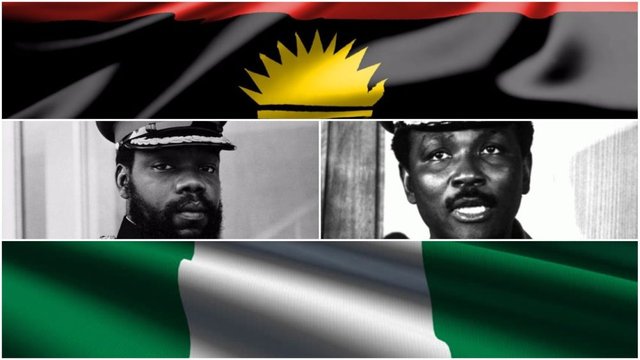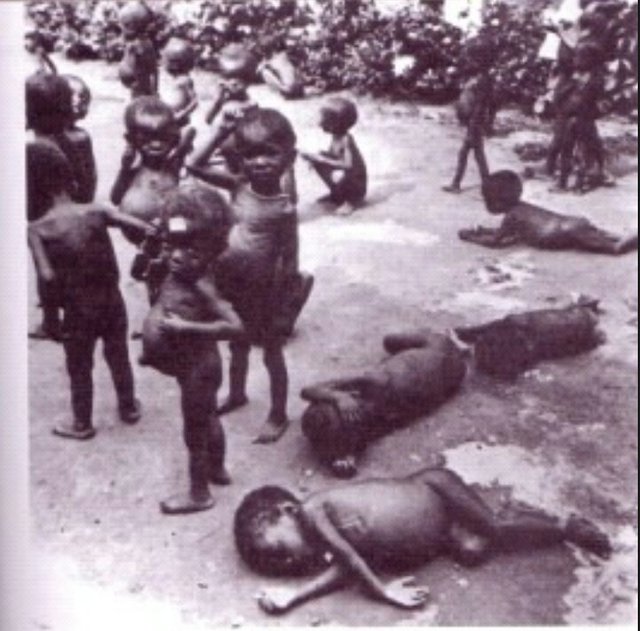 The Nigerian Civil War which in the south east part of the country in present days is still regarded as a genocide against the Igbo people
The Nigerian Civil War which in the south east part of the country in present days is still regarded as a genocide against the Igbo people  , popularly known as the Nigeria-Biafra War which lasted from 6th July 1967 – 15th January 1970 almost destroyed the unity of Nigeria.
, popularly known as the Nigeria-Biafra War which lasted from 6th July 1967 – 15th January 1970 almost destroyed the unity of Nigeria.
The Civil War was fought to reintegrate and reunify the country. It was a result of the Nigerian government’s efforts to counter the struggle by Igbo people of the Eastern Region to break away from Nigeria under the new name – The Republic of Biafra led by a military officer and politician, late Chukwuemeka Odumegwu Ojukwu.
It is believed that the war became inevitable because the Igbo people felt they could no longer co-exist with the Northern-dominated Federal Government of Nigeria.
The Nigerian Civil War which broke out on 6 July 1967 and lasted until January 15, 1970, was the culmination of an uneasy peace and instability that had plagued the Nation from independence in 1960.
It was a result of a long period of alleged political, economic, ethnic, cultural and religious deprivations, which had its genesis in the geography, history, culture and demography of Nigeria.
Biafran States
The Republic of Biafra was mainly made up of the former Eastern region of Nigeria and was inhabited principally by the Igbo ethnic group. Biafra has been commonly divided into four main “tribes” which include: the Igbos, the Ibibio-Efiks, the Ijaws and the Ogojas.
The modern-day states that make up Biafra from the eastern region and Midwest are Abia, Anambra, Akwa Ibom, Bayelsa, Enugu, Ebonyi, Imo, Delta, Rivers and Cross River, Igbanke in Edo state and southern part of Benue state. Edo.
Biafran Flag
The flag of the Republic of Biafra was created by the Biafran Government and raised on May 30, 1967. It consists of red, black, and green horizontal colours. At the middle of it, a golden sun rises over a golden bar; the sun has eleven rays, representing the eleven provinces of Biafra.
The Red Pan-African color on the Biafra flag represents the blood that unites all people of Black African ancestry and shed for liberation.
The Black colour represents the black people whose existence as a nation, though not a nation-state, is affirmed by the existence of the flag.
The Green represents the abundant natural wealth of the region.
Biafran Currency
The Republic of Biafra had a different currency from that of Nigeria – the Biafran pound which went public on 28 January 1968.
The Biafran government created the Bank of Biafra, accomplished under “Decree No. 3 of 1967”. The bank was administered by a governor and four directors; the first governor, who signed on bank notes, was Sylvester Ugoh.
The currency of Biafra had been the Nigerian pound until the Bank of Biafra started printing out its own notes, the Biafran pound. It is estimated that a total of £115–140 million Biafran pounds were in circulation by the end of the war.
The Genesis
The immediate cause of the civil war may be identified as the coup and the counter coup of 1966 which altered the political equation and destroyed the fragile trust existing among the major ethnic groups.
Before the full-blown war, there was a military coup in 1966 (carried out by Maj. Nzeogwu which led to the death of Tafawa Belewa, among others), a counter-coup (led by Gowon, which led to the brutal murder of Aguiyi Ironsi, Fajuyi, among others) and a persecution of the Igbo people living in Northern Nigeria, forcing them to return home. Even on their way home, many of them were killed in disturbing circumstances.
There have been divided opinions on the 1966 coup as some argue that corruption among the civilian ruling class pushed the military to organize the coup, while others opine that the control of oil production in the Niger Delta was also a major factor.
In May 1967, the Federal Military Government divided the country into twelve states from the original four regions, but the former Eastern Region under Lt. Col. Ojukwu saw the act of the creation of states by decree “without consultation” as the last straw, and declared the Region an independent state of “Biafra”.
Consequently, the Federal Military Government saw this act of secession as illegal. Several meetings were held to resolve the issue peacefully without success. To avoid disintegration of the country, the central government was left with no choice but to forcefully bring back the region to the main fold.
As soon as the war began, the Federal Military Government of Nigeria led by General Yakubu Gowon surrounded the Biafra territory and captured the oil –rich coastal areas.
The blockade imposed during the war led to severe famine such that within the two and half years (30 months) the war lasted, there were over 100,000 overall military casualties, while nearly two million civilians died from starvation, which was a deliberate policy adopted by Nigeria to bring the people on the Biafra side to their knees.
Western powers were also involved in the war, with Britain and the then Soviet Union backing Nigeria, while France and a few other countries supported Biafra.
The Biafra Civil War And Its End
At the orders of the Federal Military Government, the Nigerian federal troops marched in two divisions into Biafra on the 6th of July, 1976. Division 1, led by Col. Shuwa operated through the north of Biafra, while the second Division advanced on Nsukka which later fell on July 14.
On the 9th of July, the Biafrans led by Lt. Col. Banjo retaliated by marching into the mid-western region of Nigeria across the Niger River, passing through Benin City and later stopped at Ore on August 21.
The Biafran troops captured the mid-west easily because there was little repulsion from soldiers guarding the region. This infuriated Gowon and he asked Col. Muhammad Murtala to form another division (Division 2) to drive the Biafrans out of mid-west and attack Biafra as well.
The mid-west region was recaptured by the Nigerian army on the 20th of September.
Authors get paid when people like you upvote their post.
If you enjoyed what you read here, create your account today and start earning FREE STEEM!
If you enjoyed what you read here, create your account today and start earning FREE STEEM!
Source
Plagiarism is the copying & pasting of others work without giving credit to the original author or artist. Plagiarized posts are considered spam.
Spam is discouraged by the community, and may result in action from the cheetah bot.
More information and tips on sharing content.
If you believe this comment is in error, please contact us in #disputes on Discord
Downvoting a post can decrease pending rewards and make it less visible. Common reasons:
Submit
Hi! I am a robot. I just upvoted you! I found similar content that readers might be interested in:
https://buzznigeria.com/biafra-nigeria-civil-war/
Downvoting a post can decrease pending rewards and make it less visible. Common reasons:
Submit